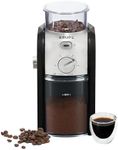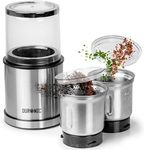Buying Guide for the Best Coffee Bean Grinders
Choosing the right coffee bean grinder is essential for brewing the perfect cup of coffee. The grinder you select can significantly impact the flavor and aroma of your coffee. When selecting a grinder, consider the type of coffee you enjoy, how often you brew, and the level of control you want over the grind size. Understanding the key specifications will help you make an informed decision that suits your coffee preferences and lifestyle.Grind Size SettingsGrind size settings refer to the range of coarseness or fineness you can achieve with a grinder. This is important because different brewing methods require different grind sizes. For example, espresso requires a fine grind, while French press needs a coarse grind. Grinders with multiple settings offer more flexibility and control over your coffee's flavor. If you enjoy experimenting with different brewing methods, choose a grinder with a wide range of settings. If you stick to one method, a grinder with fewer settings may suffice.
Burr vs. BladeThe type of grinder mechanism is crucial for consistency and quality. Burr grinders use two revolving abrasive surfaces to crush the beans, providing a uniform grind size, which is essential for balanced flavor extraction. Blade grinders, on the other hand, use a spinning blade to chop the beans, resulting in an uneven grind. Burr grinders are generally preferred for their precision and consistency, making them ideal for coffee enthusiasts. If you're looking for a quick and simple option, a blade grinder might be sufficient, but for the best results, a burr grinder is recommended.
Grind CapacityGrind capacity refers to the amount of coffee beans a grinder can process at one time. This is important if you regularly brew large quantities of coffee or if you want to grind beans for multiple servings at once. Grinders with larger capacities are suitable for households with multiple coffee drinkers or for those who entertain guests frequently. If you typically make coffee for just yourself, a grinder with a smaller capacity will be more than adequate and may save counter space.
Material and Build QualityThe material and build quality of a grinder affect its durability and performance. Grinders made from high-quality materials like stainless steel or ceramic tend to last longer and perform better over time. They are also less likely to impart any unwanted flavors to your coffee. If you plan to use your grinder daily, investing in a well-built model is wise. For occasional use, a grinder with a simpler build may be sufficient, but ensure it is sturdy enough to withstand regular use.
Ease of CleaningEase of cleaning is an important consideration because coffee grinders can accumulate oils and residues that affect the taste of your coffee. A grinder that is easy to disassemble and clean will help maintain the quality of your coffee over time. Look for models with removable parts or those that come with cleaning tools. If you value convenience and want to ensure your grinder remains in good condition, prioritize ease of cleaning in your selection.















